Jeanne Lanvin: Youth, Elegance & Transatlantic Style in the Age of Steamships (1908–1920s)
📌 Explore the iconic fashion of Jeanne Lanvin, celebrated Parisian designer of the early 20th century. With vivid illustrations and historical context, this article highlights Lanvin’s influence on ocean travel, youth fashion, and haute couture—ideal for students, teachers, genealogists, and fashion historians.
Jeanne Lanvin – Dressing the World with Elegance, From Paris to the Promenade Deck (1908–1920s)
A Fashion History Resource for Teachers, Students, Genealogists & Historians
🧳🧵⚓
👗 Introduction: Jeanne Lanvin – The “Modiste to Youth” and Maritime Sophisticate
Jeanne Lanvin (1867–1946), one of the most visionary couturières of early 20th-century Paris, made fashion that transcended the salon and swept across continents—especially by steamship. This archival article, with stunning images from Harper’s Bazar, Les Modes, and other leading publications, offers a vibrant cross-section of Lanvin’s output during her golden years: 1910 to the early 1920s, when fashion met modern femininity, youth culture, and international travel.
🌍 Lanvin’s designs were worn by the young debutantes of New York, schoolgirls boarding transatlantic liners, stage stars in Parisian theaters, and women of independent means with a suitcase full of satin and taffeta.
This makes the article a treasure trove for educators, students, and researchers interested in:
🧳 Transatlantic travel culture
🧵 Fashion history
💃 Women's roles in early 20th-century society
🧬 Genealogy (especially identifying social class & lifestyle clues in family photos)
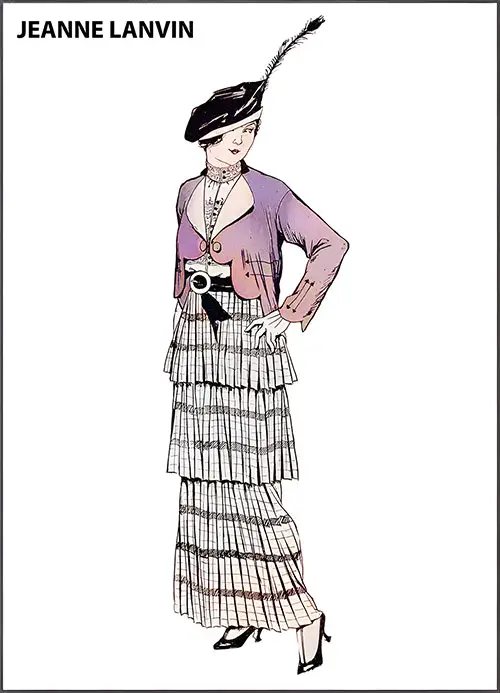
The Street Suit From Jeanne Lanvin Is Charming and Girlish. The Little Jacket Is of Black Duvetyn With Revers of Yellow Duvetyn and Small Black Velvet Collar. It Has a Curious Cut in the Front, Revealing the Black Satin Girdle Run Through an Amber Buckle. Three Plaited Flounces of Black and Yellow Plaid Compose the Skirt. Glimpses of the Gold-colored Crêpe de Chine Blouse Embroidered in Old Gold Can Be Seen Even When the Coat Is Worn. Harper's Bazar, November 1913, p. 46. | GGA Image ID # 1ca720c396
Jeanne Lanvin, the mastermind behind the captivating 'Maroussia,' has crafted a unique piece from Marocain Greg, adorned with sleeves of antique cashmere. The skirt, a testament to her artistry, is intricately stitched in the colors of the cashmere.
Lanvin's fashion is a vibrant blend of joy, alertness, and youthfulness. Her designs are a treasure trove of ideas, a testament to her robust imagination and meticulous attention to detail, a rarity in the fashion capital of Paris.
When Lanvin ventures into the realm of the early Victorian period, she doesn't just explore, she transforms. Her designs take on a quaint and pretty charm, a testament to her ability to breathe new life into neglected eras.
The tailor is made of very modern stuff. Kashavella, burnouses, duvetyn, and velvet are straight. The coats are short and loose with standing collars and flaring cuffs, often faintly embroidered all over in opposition to a perfectly plain skirt.
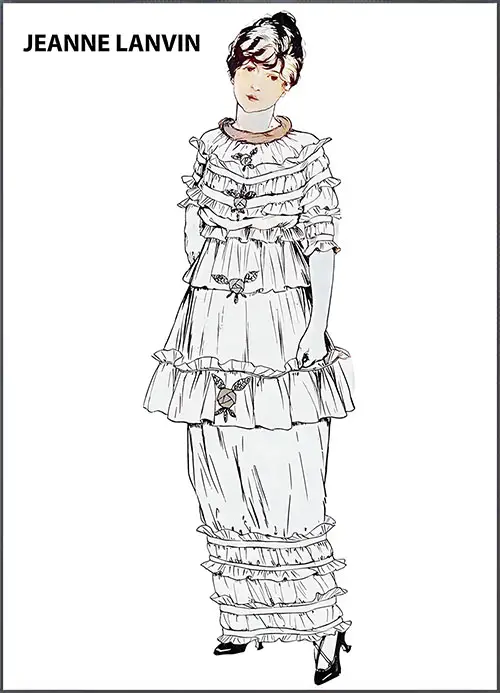
Jeanne Lanvin Accents Youth's Picturesqueness in This Coming-out White Net Gown. The Fulness at the Feet Is Restrained by Shirring Caught Into Bands of White Satin Ribbon. The Wired Tunic Continues the Bouffant Effect, Finished With a Deep Flounce. The Tunic and Peplum Are Each Seen With a Rose and Leaves Made of Varicolored Beads. The Waistline Is Lost to Sight Under the Numerous Shirring That Makes up the Bodice. Harper's Bazar, November 1913, p. 47. | GGA Image ID # 1ca742aac4
Little capes, cleverly designed to match the jackets in length, offer a delightful twist. Their unique feature of being detachable, allowing them to be worn separately, adds a touch of intrigue to the ensemble.
Agnella, the exquisite imitation of lamb, takes center stage at Lanvin's. A striking example is a blue Kashavella, featuring a high collar at the back and a second identical collar and waistcoat crafted from pristine white Angela.
A collection of medium coats, slightly pinched at the waist and tailored with a touch of severity, is introduced. One notable piece is a black velvet model, adorned with a gold braid and featuring an eighteen-inch basque of monkey. This use of monkey, a prevalent trend, is a testament to the current fashion landscape.
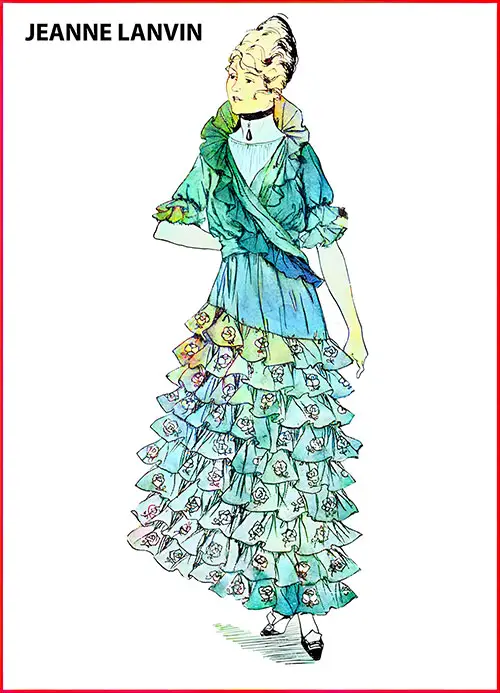
The Ruffled Crinoline Skirts of 1830 Have Been Revived by Jeanne Lanvin, the Modiste to Youth. A Dainty Little Frock of Old Blue Taffeta Has Tier Upon Tier of Taffeta Ruffles Gay With Appliqued Beaded Roses. Fichus of the Taffeta, With Bias, Gathered Ruffles, Ripple Over the Tight Little Bodice With Puffed Sleeves Edged With the Ruffles. Harper's Bazar, April 1914, p. 50. | GGA Image ID # 1ca75f22a2
Coats are ample and very often have a cape over them. A highly original way of managing this effect is to wear a huge square of fur over a coat. The square covers the sleeves and hangs down the back. One example is a black Mongolian goat on black duvetyn; another idea is a fur bolero just to the waist on a woolen wrap.
The sleeves and sides of a coat may be made of different stuff or inlet with appliqué work. Of course, the coats are assorted to a dress; tinsel and metal embroidered in stripes, checks, squares, or triangles are much appreciated; the same work is repeated on the frock. Cut steel and marcasite are also beautiful.
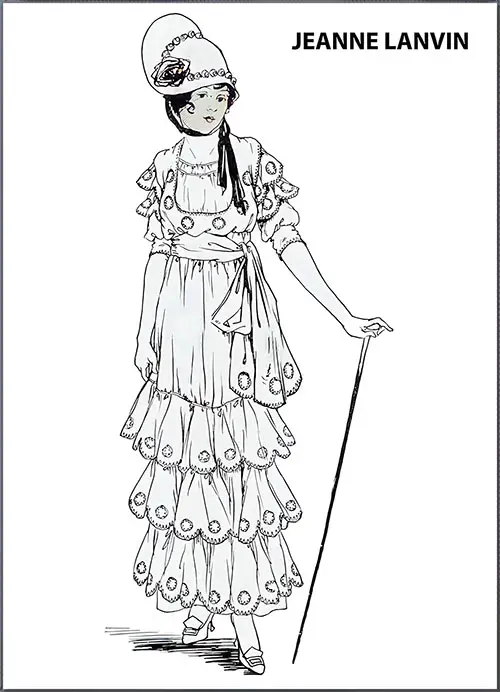
Another 1830 Frock Shown by Jeanne Lanvin Is of White Net Embroidered in Blue. Three Ruffles, Very Full and Flaring, Trim the Bottom of a Gathered Old-time Skirt. Narrower Ruffles Form the Sleeves and Almost Conceal the Bébé Puffs, Assembled Into an Embroidered Band at the Elbow. A Sash of White Taffeta, Likewise Embroidered in Blue, Completes This Gem of a Dress. Harper's Bazar, April 1914, p. 50. | GGA Image ID # 1ca778bd54
A coat forming a "dalmatique" or priest's vestment is a new shape: it is very long and straight in the back, with two shorter panels coming over the front. Pale yellow and a gray squirrel is pretty and novel as a wrap.
Velvet is used more than any other dress material: dark blue trimmed with a much brighter blue run through the collection. Velvet bodices worn with plaid woolen skirts are a charming combination.
Charmeuse, crêpes de Chine, and Georgette are the next most popular fabrics. Many monkeys are used, especially for edging and trimming coat dresses.
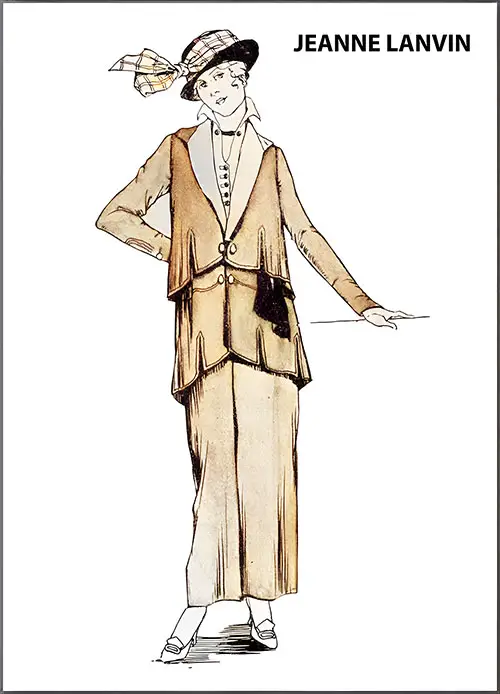
A Pet Color Scheme Affected by Jeanne Lanvin Is Black Serge With Trimmings of the King's Scarlet. Black Stitching Decorates the Curiously Shaped Tunic and the Edges of the Bolero Jacket—Revers and Buttons of Scarlet Broadcloth and a Ribbon Sash Complete the Costume. Harper's Bazar, April 1914, p. 51. | GGA Image ID # 1ca7b43dc0
We have long flat lines, flat backs, fronts, gathered sides, straight across-the-shoulder necklines, and wide bishop sleeves. The skirts are a little longer than usual, about six inches off the ground.
Lanvin is fonder of embroidery than almost any other house. In addition to the forms already described, we may mention designs made of triangular incrustations of velvet on Georgette, with chiffon covered with rounded taffeta petals overlapping and many steel nails studding velvet.
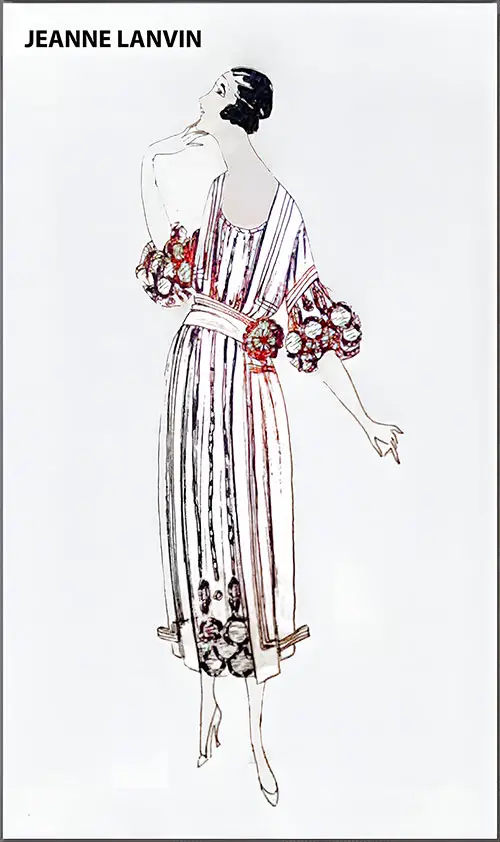
"Automne," an Afternoon Frock Also From Jeanne Lanvin. This Model Is Developed in Black Taffeta Over a Turco Blu Foundation. The Front and Graceful Sleeves Are Decorated With an Embroidery Made of Narrow Shirred Ribbon and Silver Thread. Garment Manufacturers' Index, August 1920. GGA Image ID # 1a3acb2db9
Among the other numerous examples I recollect, very charming coral embroidery on loose panels is a good way of weighing them down, especially when the girdle is chiffon rolled together with strings of coral "teeth."
The typical evening dress is distinctly Victorian, with flat, off-the-shoulder bodices and taffeta skirts. The skirts are placed with immensely wide bells of tulle much longer than the lining and stiffened to an ample hemline by various artifices.
Black and white tulle rushing rows trim one pink taffeta and net. Another white silk and tulle are striped in yellow roses, and a garland surrounds the décolleté. A mauve example has large panels of mauve taffeta petals.
The other line for evening wear is straight, with much embroidery, steel, and diamonds predominating. Square décolletés, very simple sheaths with a coat or cape forming a train at the back, are the rule. Beaded, jetted, and embroidered net is generally used with a great deal of silver and silver cloth.
Paris importations for Young Women
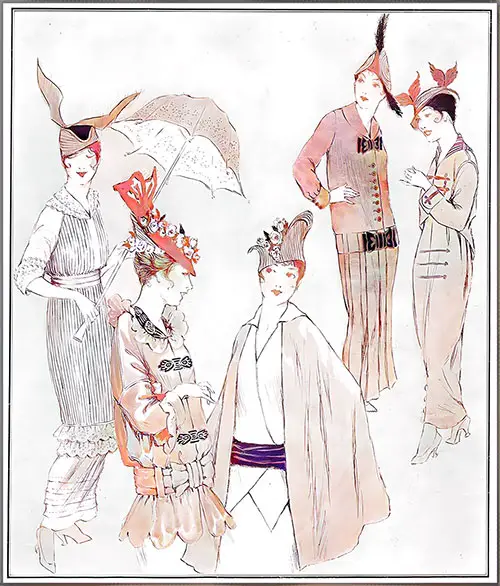
Paris importations for Young Women. Harper's Bazar, May 1914, p. 7. | GGA Image ID # 1ca81c8429
A Dress Into Which the Owner May Slip Quickly and Efficiently When the Breakfast Bell Is Ringing Is a Necessity in the Wardrobe of the School Girl. Though it must be kept simple in construction, it may bear the hallmarks of the newest models, such as this school dress from Fairyland.
Novelty Striped or Checked Materials Could Be Utilized To Excellent Advantage in the Skirt, and the Dominant Color Reflected in the Blouse of the Plain Fabric. A Curious Medallion of Oriental Origin Brings the Blouse Out of the Realm of the Commonplace, Pipings Being the Only Other Attempt at Trimming.
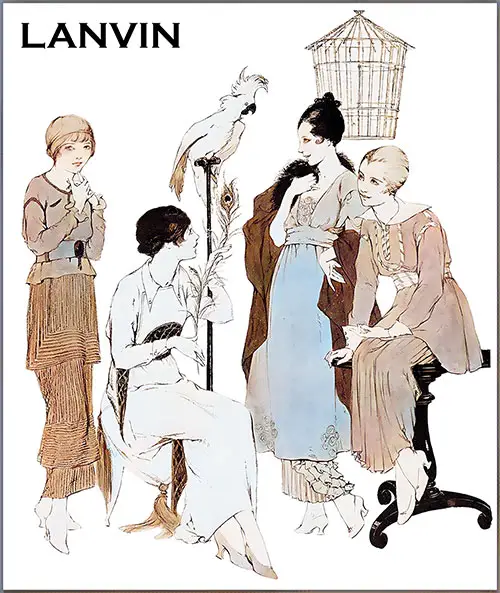
One Could Interpret This Charming Youthful Model From Jeanne Lanvin Equally Well in Serge or Silk. In Taffeta or Crêpe de Chine, It Could Serve as a Pretty Gown for Dinner During the Week. The Yoke, Belt, and Sash May Be of the Material Embroidered in Contrasting Colors, Oriental Embroidery, or Again of Figured Silk. The Bodice's Bib Effect Is Delightfully Youthful Yet Doesn't Detract From the Model's Simplicity. The Upper Part of the Bodice and the Long Sleeves Are Cut In One Piece, the Fullness Under the Arms Making the Sleeves Perfectly Comfortable. Harper's Bazar, August 1914, p. 36. | GGA Image ID # 1ca8f0962c
At all boarding schools or colleges, at least one evening gown is required for the various " dress-up" occasions. This charmingly youthful model, worn by a well-known débutante at the première of Parsifal, offers many valuable suggestions.
It is developed in pink pussywillow taffeta, and the full long tunic is mounted over an underskirt of accordion plaited chiffon, made even more fluffy and full by four circular ruffles at one side.
Except for the two medallions of pink crystal beads on either side, the tunic is devoid of trimming. Ruffles boned with bias bands serve as the most alluring sleeves for the simple little corsage decorated with a beaded medallion.
Another of the school dresses from Fairyland would be serviceable and good-looking, fashioned from navy blue or brown serge. The underskirt is frankly plaited, a style which invariably appeals to the school girl who insists upon freedom of movement.
The bodice suggests the Russian blouse with just enough modification to make it enjoyable. It is loosely belted at the customary waistline by a novelty taffeta silk girdle drawn through straps of the material. Silk is used for the pipings that outline the vest, the armholes, and the seams. The sailor collar and cuffs are made detachable.
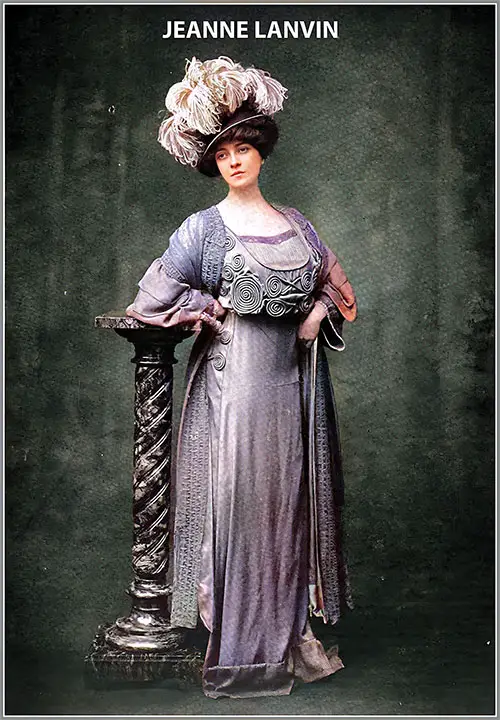
Exquisite Outfit and Hat from Jeanne Lanvin. Les Modes, April 1908, Front Cover. | GGA Image ID # 1cb1c54214
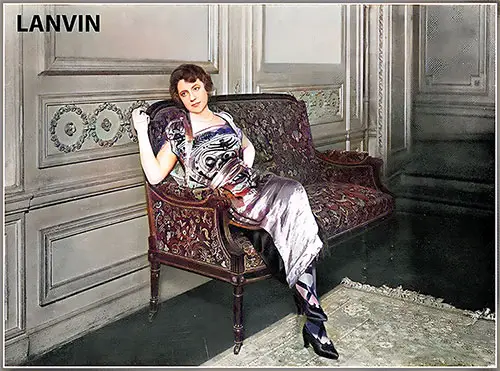
Mlle Cézane, in Les Amants de Sazy, au Thétre Michel, Dressed by Jeanne Lanvin. Phot oby Henri Manuel. Les Modes, Issue 182, March 1919, p. 6. | GGA Image ID # 1ce05e8c90
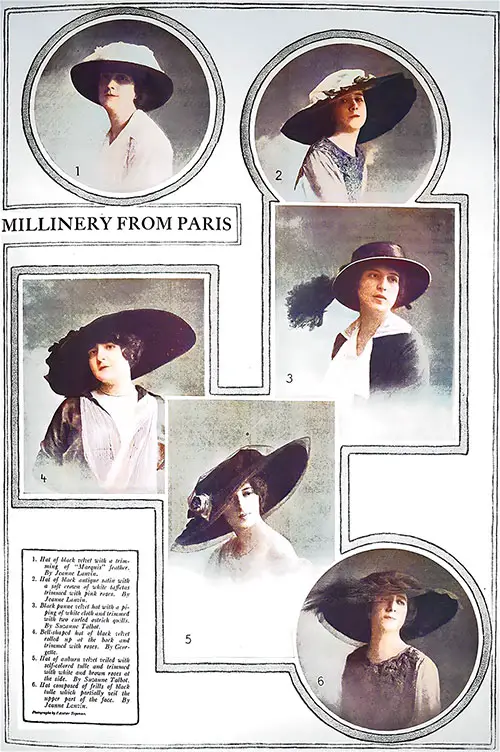
Millinery from Paris by Lanvin, Talbot, and Georgette, 1912. (1) a Black Velvet Hat With a Trimming of a “Marquis” Feather by Jeanne Lanvin. (2) a Black Antique Satin Hat With a Soft Crown of White Taffetas Trimmed With Pink Roses by Jeanne Lanvin. (3) Black Panne Velvet Hat With Piping of White Cloth and Trimmed With Two Curled Ostrich Quills by Suzanne Talbot. (4) Bell-Shaped Hat of Black Velvet Rolled up and Trimmed With Roses by Georgette. (5) Suzanne Talbot Veiled a Hat of Red Velvet With a Self-Colored Tulle Trimmed With White and Brown Roses on the Side. (6) Hat Composed of Frills of Black Fulle Which Partially Veil the Upper Part of the Face, by Jeanne Lanvin. Photographs by L’atelur Toponier. (The Delineator, October 1912) | GGA Image ID # 217ee259ef
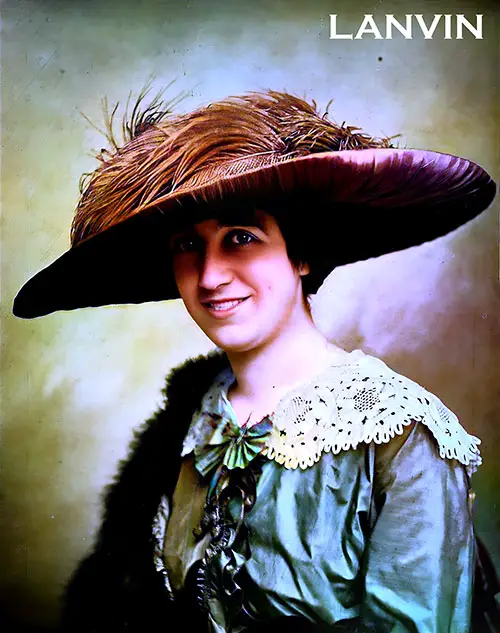
Hat by Jeanne Lanvin Comprised of a Large Hat of Pleated Taffeta, Trimmed with Ostrich Feathers. (Les Modes, March 1912) | GGA image ID # 22499d6aa0
Paris Creators of Apparel Style: Lanvin
Jeanne Lanvin, one of the most daring innovators of style, began her journey as an independent owner of a couture establishment in Paris in 1902. Her rise in the fashion industry, after an apprenticeship and training in other houses beginning in millinery in the latter 1880s, is a testament to her determination and talent.
It is said that her work as a designer first came to her attention through a dress that she made for her young daughter. The dress attracted so much attention that she was virtually urged into the designing and couture business.
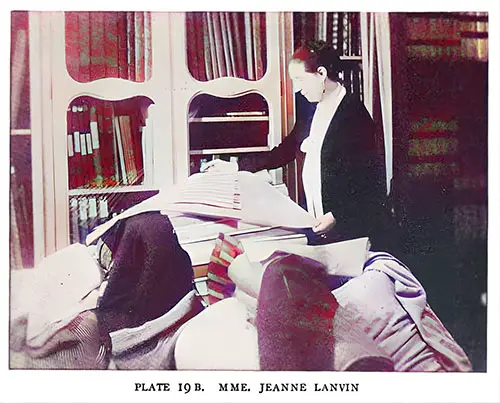
Plate 19B: Mme. Jeanne Lanvin. (Economics of Fashion, 1928) | GGA Image ID # 225b408b2d
Jeanne Lanvin's productions are the products of her design. She is the sole designer in her establishment. She seems very fond of organdy and frequently uses black and white. Highly artistic effects characterize her work. Her new lines of models for every season include robes de style, picturesque bouffant frocks, much use of taffeta, filmy black net, Bertha collars, long bodices, and so on.
It has been stated that while Lanvin lives, the bouffant mode will never die. She is also a very successful designer of sports apparel of the type of "spectator sports." Jeanne Lanvin's influence on women's fashion is profound, making her the dressmaker par excellence to French women. She also enjoys a considerable trade with South American customers, particularly from the Argentine. She has a successful branch in Buenos Aires.
In addition to her work in couture, Mme. Lanvin conducts a successful men's tailoring shop—the first by a woman dressmaker—and is also an interior decorator much in demand for theatrical scenes and fine homes. Her achievements in these fields are a testament to her diverse talents and make her one of the few French women who has been honored by appointment as a Chevalier de la Legion d'Honneur.
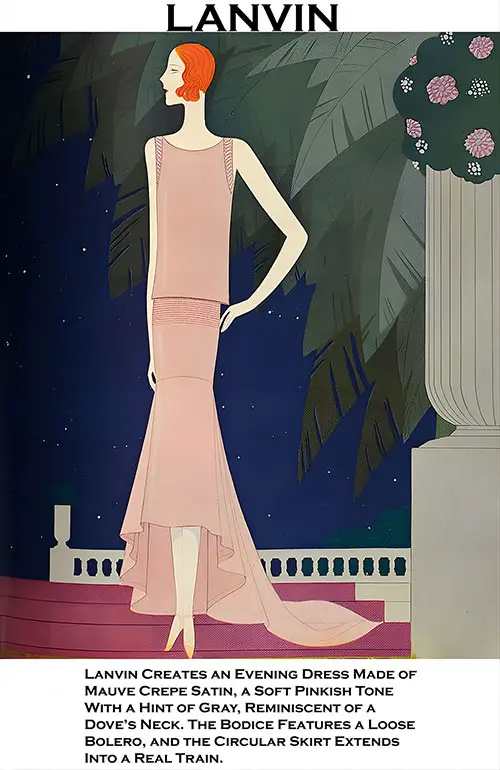
Lanvin Creates an Evening Dress Made of Mauve Crepe Satin, a Soft Pinkish Tone With a Hint of Gray, Reminiscent of a Dove’s Neck. The Bodice Features a Loose Bolero, and the Circular Skirt Extends Into a Real Train. (Harper's Bazar, August 1929) | GGA Image ID # 22600f6b6a
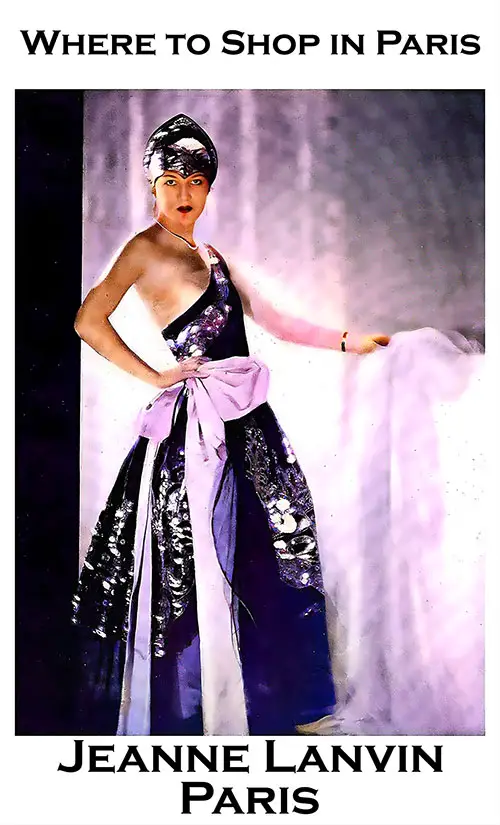
1927 Advertisement for Jeanne Lanvin - Where to Shop in Paris Campaign. Shows a Stunning Gown with a Bow Belt. (Harper's Bazar, July 1927) | GGA Image ID # 2267148591
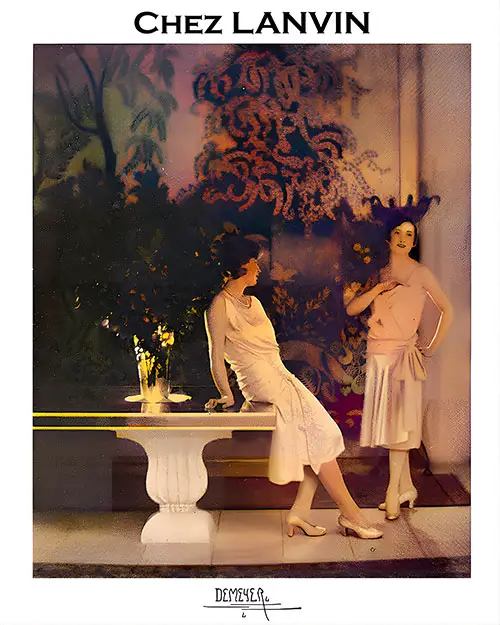
Chez Lanvin. Photo par Baron De Meyer. Tous Les Modeles Deposes. (Harper's Bazar, October 1927) | GGA Image ID # 226fba7750
chez Lanvin (October 1927)
The Lanvin collection is a unique manifestation of personal expression that is impossible to duplicate. It's a testament to the imaginative qualifications needed for designing an entire collection and a celebration of remaining true to oneself.
I never felt the Lanvin atmosphere, a unique blend of elegance, innovation, and tradition, expressed as strongly as in this collection. Madame Lanvin had only recently assured me that this season's novelty would be the 'Lanvin atmosphere intensified.' She has certainly kept her word, for this is one of the best collections she has ever produced, which might easily take its name from the luck-bringing penguin, as, with obvious exceptions, it is, from A to Z, the 'black-and-whitest' collection which anyone has ever designed.
The collection starts with a diagonally zebra-striped tweed, a 'Rodier special.' The use of this material in several suits and coats, some with Breton jackets and blouses tucked into skirts, is a testament to the innovative styles in this collection. The long coats, semi-fitting and indicating the waistline, result in modernized hourglass figures, showcasing the innovative approach of the designer. The most original coat, circular and cut on one side only, gives the impression of a swirling Spanish 'Capa.'
This garment, repeated in five different editions, is undoubtedly 'the' Lanvin model of the season. An elegant black faille golf jacket is worn over a white grosgrain waistcoat and a long black velvet sports overcoat. It is lined and collared with ermine. Madame Lanvin's partiality to buttons is well known, though she generally uses them for decorative purposes only. This model, with its unique combination of fabrics and attention to detail, truly embodies the essence of the Lanvin collection.
One model is named 'Rubis' because of a large single ruby button on a gray Moroccan gown, while another, 'Solitaire,' has a specially large diamond fastening the collar. Evening skirts droop in the back and brilliant spangled textures are used as much as ever. These Lanvin specialties reflect the brand's commitment to luxury, elegance, and attention to detail.
An attractive series of chiffon and lace evening gowns is particularly original. Are the new "robes de style" in black or all white? The black models, lavishly ornamented with strass, are very much puffed out.
Some others consist of thousands of tiny frills reaching high up to the waistline. "Lohengrin" and "Walküre" are amazing black creations that have dazzling armor-like bodices, while "Cielde Naples," consisting of masses of sapphire-blue spangles over black net flounces, is a dream of loveliness.
Midnight blue velvet combined with much turquoise jewelry is another novelty, as are jeweled flower garlands made into neckbands. The latter are particularly attractive.
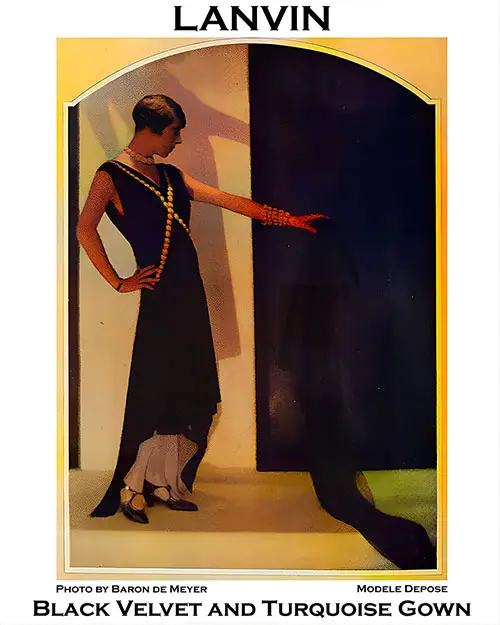
Black Velvet and Turquoise Gown by Lanvin. Photo by Baron de Meyer. Modele Depose. (Harper's Bazar, November 1927) | GGA Image ID # 22729cba3e
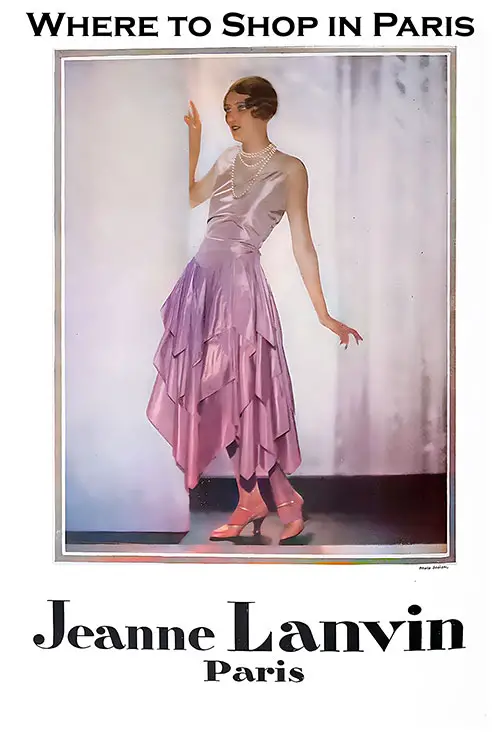
Jeanne Lanvin - Where To Shop In Paris. Photo by Scaioni. (Harper's Bazar, December 1927) | GGA Image ID # 2272a83d70
Bibliography
"Lanvin" in the Garment Manufacturers' Index, New York: The Allen-Nugent Co. Publishers, Vol. II, No. 2, September 1920: 26-27.
Baron de Meyer and Marjorie Howard, "What Is New in Paris: The Autumn Collections of The Great Paris Houses: Chez Lanvin," in Harper's Bazar, New York: International Magazine Company, Inc., Year 61, No. 2580, October 1927: The Paris Openings Number, Illustrated By Baron de Meyer, Bernard B. Demonvel, Mary Mackinnon, Reynaldo Luza, and Dynevor Rhys, p. 80.
"Paris Creators of Apparel Style: Lanvin," in Economics of Fashion, New York: The Ronald Press Company, 1928, pp. 215-216.
⛵ Relevance to Ocean Travel & Fashion
Lanvin’s clothing was perfectly suited for women of the Saloon Class aboard grand liners like RMS Carmania or Lusitania. Her designs embraced:
🔹 Layering and warmth for cold ocean crossings (think monkey-trimmed coats or Mongolian goat wraps 🐐)
🔹 Easy dressing solutions for travel days (like the “breakfast bell” dress!)
🔹 Parisian flair for evenings onboard, with net gowns, beaded tunics, and Victorian revival skirts
🔹 Charming youth-centric fashion for young ladies, debutantes, and schoolgirls traveling abroad
✨ Whether promenading on deck, attending a shipboard concert, or arriving in Liverpool, Lanvin’s clients were dressed to dazzle and express modern elegance.
🧷 Most Engaging & Educational Highlights
1. 🖼️ The Street Suit with Plaid Flounces | Image ID: 1ca720c396
“Three plaited flounces of black and yellow plaid compose the skirt… glimpses of a gold-colored crêpe de chine blouse embroidered in old gold.”
This youthful and vibrant ensemble is quintessential Lanvin. The contrast of amber accents with duvetyn and velvet makes it ideal for public appearances—whether shopping in Paris or stepping off the gangway in New York.
2. 🖼️ Victorian Revival Dresses (1830 Inspiration) | Image IDs: 1ca75f22a2 & 1ca778bd54
“Ruffled crinoline skirts of 1830 have been revived… tier upon tier of taffeta ruffles… old blue or white net embroidered in blue.”
Lanvin’s fusion of past and present is key to her design philosophy. These gowns reflect the romantic nostalgia popular among debutantes and women seeking soft, voluminous silhouettes in contrast to more rigid, tailored styles.
3. 🖼️ “Automne” Afternoon Frock | Image ID: 1a3acb2db9
“Black taffeta over a Turco Blu foundation… embroidery made of narrow shirred ribbon and silver thread.”
A masterclass in color layering and textile contrast, this model reflects how Lanvin played with metallic thread and dramatic volume, making it ideal for both city salons and cruise ship dining rooms.
4. 🖼️ Lanvin’s Millinery Magic | Image IDs: 217ee259ef & 22499d6aa0
Hats of antique satin, velvet, pleated taffeta—trimmed with ostrich feathers, roses, and veils.
Hats were essential for shipboard fashion. Lanvin’s wide-brimmed and veiled hats provided both sun protection and flair, making her work indispensable for women traveling between continents.
5. 🖼️ Boarding School Travel Fashion | Image IDs: 1ca8f0962c & 1ca81c8429
“A dress into which the owner may slip quickly… may bear the hallmarks of the newest models.”
Ideal for educators! These pieces reflect how fashion was integrated into daily life for young women studying abroad or traveling with family—highlighting social class expectations, age-appropriate dressing, and the emerging independence of girls in this era.
🖼️ Noteworthy Image Gallery (For Presentations & Teaching)
Image ID | Description
1ca720c396 Youthful black and yellow street suit
1ca742aac4 Coming-out gown with rose-beaded embellishments
1ca75f22a2 1830-inspired blue taffeta gown
1ca778bd54 White net dress with blue embroidery
1ca7b43dc0 Black serge & King’s Scarlet trimmed suit
1a3acb2db9 “Automne” taffeta & silver-thread dress
217ee259ef Parisian millinery selection
1ca8f0962c School travel dress with Oriental embroidery
1cb1c54214 Cover photo ensemble & hat from Les Modes
1ce05e8c90 Stage costume from Théâtre Michel
22499d6aa0 Pleated taffeta hat with ostrich feathers
📖 Glossary of Fashion Terms
Basque: A fitted extension of the bodice below the waist, often forming a skirt-like tail.
Crêpe de Chine: Lightweight silk with a slightly crinkled texture.
Dalmatique: A loose ecclesiastical robe used as inspiration for long, flowing coats.
Duvetyn: Soft, velvety woolen fabric, often used in coats and wraps.
Girdle: A decorative or functional belt at the waist.
Kashavella: ikely a stylized fabric name combining "cashmere" and "vellum" (meaning soft and drapey).
Medallion: Decorative motif (often beaded or embroidered) used to embellish garments.
Pussywillow Taffeta: Lustrous, textured taffeta named for the soft sheen of the plant.
Tunic: A loose-fitting top that falls below the hips—often layered.
🎓 For Educators, Students, Historians & Genealogists
🔍 Educators:
Use Jeanne Lanvin’s designs to introduce students to fashion history, design techniques, and social norms of the early 20th century.
Great resource for analyzing fashion as personal and political expression.
Consider project prompts like: “Design a transatlantic wardrobe for a debutante using Lanvin’s principles.”
📚 Students:
Ideal source material for essays, presentations, or visual timelines on:
🔹 Parisian fashion innovation
🔹 Women’s changing roles in society
🔹 Youth fashion and modernity
🧬 Genealogists:
Use the described styles to help date family photographs
Understand what your ancestors might have worn while traveling or living abroad
📸 Historians:
Lanvin’s work illustrates the cross-pollination of European and American style, as well as the feminization of fashion entrepreneurship in Paris.
💬 Final Thoughts – Jeanne Lanvin’s Legacy Afloat & Ashore
Jeanne Lanvin’s clothing was more than beautiful—it was transformational. She dressed the emerging modern woman, from the stage actress to the schoolgirl, from the Parisienne to the American debutante crossing the Atlantic.
Her genius lay in balancing:
🎭 Historic revival with modern edge
🧳 Functionality with couture sensibility
🧵 Craftsmanship with youthful charm
🌍 Her work reminds us that fashion travels, both literally (on liners and trains) and culturally—shaping identities across oceans and generations.
✒️ Students are encouraged to cite and explore this article and the GG Archives’ Fashion Collection when writing papers or creating class projects.
